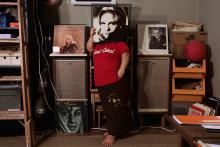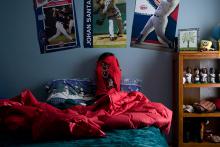October 10, 2014 - 09:46



"Peggy Lee" "T Shirt"

"Shower"
by Laura Swanson
VULNERABILITY AND POWER
A typical portrait is made up of a single person facing the audience with a plain background. The scene of the portrait appears insignificant as the audience is drawn to the face and/or body of the subject. Portraits allow the audience to stare and encourage them to focus on the small features that make up the subject. Many compare self-portraits of artists to autobiographies of writers. Laura Swanson challenges both the audience’s need to stare as well as the lack of humanity depicted in typical portraits within in her anti self -portraits.
Swanson covers herself behind various objects within rooms of her house in order to taunt the audience who are often given the subjects face and body. In the portrait “shower”, Swanson stands erect and facing the audience behind a sheer shower curtain. Her body is outlined yet, the details of her face are disguised, taunting the audience and forcing them to stare longer. This technique is also used in “t shirt”, as Swanson lies in bed with her legs covered by a sheet and her head hidden within her shirt. The audience is, again, only given her general body shape and size. Swanson’s size is highlighted throughout her works within her anti self-portrait collection even though her face is covered in all of the portraits. She uses this technique to make a comment about not only the gaze of spectators at portraits but also, the stares she receives in society due to her height. In her anti self portraits she is allowing the viewers see what causes them to stare, her size, but she doesn’t allow them to see her face and therefore not giving them power.
The power in the photos is within the gaze but not Swanson’s gaze, the gaze of the objects surrounding her. In “ Peggy Lee” Swanson covers her face using an album cover with the face of a woman on it that stares directly at the audience. Swanson surrounds herself with various albums that also include faces that glare back at the audience. This taunts the audience even more in that they can see the faces of individuals on albums but they still are unable to see Swanson’s face. Similarly, in “t-shirt” a red shirt with a cat, that stares back at the audience, covers her face. Swanson lies on her bed encircled by objects that like the shirt and albums stare back the audience such as a small Sponge Bob toy, five bobble heads and snowmen on her pillowcase. Both portraits cause the audience to be uncomfortable being that they are being stared at by a group of objects. Due to Swanson’s presence and her covered face the audience is made to feel that she is doing the staring while they are unable to know what she truly looks like. This causes the audience to feel vulnerable which differs greatly from the typical portrait that allows the audience to stare at the subject while being stared back at or looked through.
The anti self-portraits are placed in a scene that is unlike a typical portrait. The anti self-portraits “t shirt” and “shower” are both within the most vulnerable rooms in a house. In “t shirt” Swanson is laying in her bed surrounded by her personal memorabilia and only half covered by her blanket. The blanket is used to depict an unveiling of Swanson. In “shower” she is vaguely seen nude in her shower behind a slightly transparent shower curtain. Both portraits are set within vulnerable rooms yet; Swanson appears in control and powerful. A stranger is able to view another’s face even if they never have a conversation with one another yet, in order to view someone in the shower or bed one must know them beyond even a simple conversation. Because portraits are so commonly focused on the face of the subject the audience forgets to examine the space around Swanson. Her vulnerability is overshadowed by the power she has by not allowing the audience to view her face and therefore not fully identify her.
The objects in the rooms that the anti self portraits are set in tell the audience more about who Swanson is and what she enjoys than her presence. Commonly, portraits only include a solitary subject with a plain background or empty room. The face, body, and clothing are what are given to the audience in order for them to better understand the subject. Swanson uses the various rooms and the objects within them to depict in herself in these anti self-portraits instead of her face. With this she is stating that a person’s face or appearance does not accurately portray them or their personality. In “t shirt” one can see the details of the baseball player bobble heads and posters that fill her room telling them that she loves baseball and probably includes it within her daily life. Swanson’s small Sponge Bob Square Pants toy tells the audience that although she is an adult she still appreciates child like objects portraying her as fun. From her snowmen pillowcases the audience know that her favorite season is probably winter. In “Peggy Lee” the audience learns about not only her music tastes but also how she prefers to listen to music. “Shower” provides the audience with intimate knowledge of what shampoos and body wash she uses. Swanson rewards members of the audience who do not focus solely on her face and body with these small details to satisfy their want to know who she is. She also challenges the typical style of portraiture that puts more importance on the face and body of a subject than details that make up who they truly are.
Within each anti self-portrait masculinity and femininity are depicted. In “shower” the soft pink bathroom is interrupted by one rather large dark blue towel. The towel seems to be out of reach for Swanson. If she chose to get out of the shower she would be clothed within the towel and protected by it. In “t shirt” her shirt has a large cat on it. Cats are commonly used within art to portray femininity. Although she is wearing this top, masculine baseball figurines that stare back at the audience, intimidating them, surround her. In “Peggy Lee” the artwork on the album she uses to cover her face contrasts to the hard wood in the speakers behind her. This tension and protection made by the masculine objects within the anti self-portraits portray her relationship with her husband. When vulnerable he encircles her and protects her from the stares of people. Again, Swanson uses the space of her Anti Self portraits to tell the audience intimate details about her that one would be unable to learn just from her face. Swanson utilizes these portraits to both be vulnerable yet, protected.
In each anti self portrait Swanson stand or sits in an erect position. She is never leaning or hunched over. In “shower” one can see that her body is standing straight forward almost glaring at the audience behind the curtain. She appears to not be intimidated or shuttered by their appearance but rather annoyed being that she stands covering her body and face purposefully. In “ Peggy Lee”, Swanson stand straight up and twist her body to face the body. The album does not seem to cover her face in shame or fear but rather a way to confront the audience without giving them all that they expect from her. She centers herself in order to give the audience what they want and force them to move their eyes around the background and details of her rooms. Her positioning make the audience feel uncomfortable and as if they are unwanted within her space yet, their curiosity and need to stare overpowers them to continue to look at her. Swanson appears to be prepared for their long stares and that is why she covers her face.
Throughout anti self-portraits Laura Swanson confronts the audience needs to stare while remaining vulnerable and strong. She intimidates the audience with her stance and stare from the objects around her. The audience finds her humanity within the objects around her that tell about her personality and life. The face that they are so accustomed to seeing within a portrait is taken away from them as if she is punishing them for staring too long at her and others. This comment relates to her disability. Swanson is constantly gawked at for her size and her personhood is detached from her as children and adults stare. They don’t ask her name or say hello yet, they want to know her body. In the Anti self-portraits Swanson forces them to see less of her body and appearance and more of her life. With these portraits she confronts the audience as well as humanizes herself. The scenes in her portraits are typical rooms in a house that any person could live in. She is not just her body but, an average person who listens to music, likes baseball, and takes showers.
